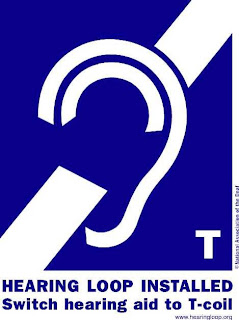 |
| International Symbol for Hearing Loop |
The need for increased awareness and use of Induction Hearing
Loops has been highlighted
in a recent report pointing at the slow adoption of this useful
and relatively low cost technology, particularly in the US.
As we live longer lives surrounded by
the sounds of traffic, construction and loud music in public, the rate of
hearing loss in the general population has steadily risen, with more and more
people using small discrete hearing aids to assist them on a day to day basis. A Hearing Aid is a device which typically fits in or
behind the wearer's ear, and is
designed to amplify sound.
One of the problems reported by
Hearing Aid users is that in noisy, open or public spaces all of the ambient
noise is amplified, and therefore it is difficult to focus on particular
sounds, like the sound of someone speaking, public announcements etc. The
technology is an Induction-Loop System (known as a Hearing Loop), whereby
electromagnetic waves produced by a microphone, public address system or
telephone receiver induce a current in the loop. The loop can broadcast the
signals directly to a hearing aid equipped with an appropriate
detector—specifically, a tiny copper telecoil wire, which picks up the signal
(also via induction) and then sends it for amplification and transmission out
of the earpiece.
Audio Induction Loops or telecoils
have been described as “Wi Fi for Hearing Aids in that they allow audio sources to
be wirelessly broadcast to a hearing aid, which makes it easier for the wearer to filter out background noise.
They can be used with telephones, FM systems (with neck loops), and induction
loop systems (also called "hearing loops") that transmit sound to
hearing aids from public address systems and TVs.
In order for a Hearing Aid user to
avail of a hearing loop in a building or public space, their Hearing Aid must
be fitted with a T-Switch or must be programmed to be compatible with such loop
systems. Following the 1995 Disability
Discrimination Act in the UK, every public building, wherever it is reasonable
to do so, must fit a Hearing Loop in order to make their activities accessible
for the Deaf and Hard of Hearing communities.
It is clear however, that the need
for similar work elsewhere in the world is now more important than ever. This has been highlighted by the recent “Get in the Hearing Loop”
campaign by the American Academy of Audiologists.
For Qatar, there appears to be much
work to be done, ensuring firstly that people who are hard of hearing know
about and understand the benefits of Hearing Aids and secondly increasing the
awareness amongst those responsible for buildings and public spaces, that
providing a Hearing Loop can make all the difference in ensuring a more
inclusive society for the country.
More information is available from:
No comments:
Post a Comment